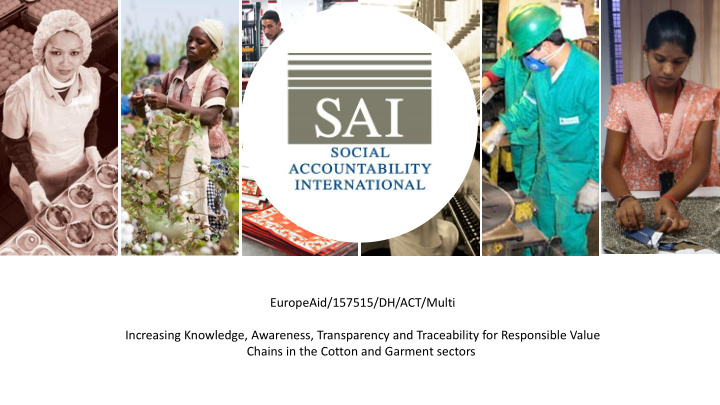



EuropeAid/157515/DH/ACT/Multi Increasing Knowledge, Awareness, Transparency and Traceability for Responsible Value Chains in the Cotton and Garment sectors
Overview • Amount: € 625,000 from EU, € 625,000 from other funders • Tim Timeli line: 3 years • Co Country ry: Bangladesh • Iss Issue: Transparency & Traceability in Supply Chains • In Industry ry: Cotton and Garment • Proje ject: : Develop an online tool that incentivizes supply chain transparency and visibility and improves buyer-supplier dialogue and workflows • Part rtners: : Social Accountability International (Lead) Technology Firm, , local NGO’s, Better Buying, European brands, Bangladesh factories Photo by SAI
Setting the context …This leads to opaque To meet buyers demands, multi-tiered supply chains, The growth of “fast suppliers will sub-contract fashion” has led to brands unknown supply chain production (unauthorized) demanding quick, flexible actors, unmonitored & require workers to work & cheap production… workplaces & vulnerable excessive overtime… workers. Bangladesh • Ready-made (RMG) sector is instrumental for economic development of Bangladesh • Total garment export trade is estimated at USD25 billion (2017) • World’s second largest exporter • 60% of export contracts are with European brands • 50% of the 7,000 garment factories are small and medium-sized indirect sourcing factories, which operate as subcontractors for larger export-oriented factories • Only 27% of factories benefitted from the USD100 million investment of the Accord and the Alliance – all of which were direct exporters, and none of which were sub-contracted factories
Problems and Solutions • Brands have no real-time vis visibility in into suppliers production capacity. • Create a Supplier Capacity Platform, a booking site, whereby suppliers can report their production capacity and buyers can book capacity for their orders. • The process of sub-contracting is is unmonitored, unregulated and la lacks tr transparency • Provide suppliers with incentives to add their sub-contracted facilities into the Supplier Capacity Platform . The goal is not to eliminate sub-contracting, but to increase transparency of the sub-contracting process. • Brands have lo low vis visibility in into working conditions at t th their suppliers and no vis visibility in into working conditions of f sub-contracted factories. • In addition to providing information about the location and production capacity of factories, product quality and ability to deliver on time etc., the Supplier Capacity Platform will also provide information on the supplier’s environmental and social compliance
Problems and Solutions (cont) • Th The buyer-suppli lier r rela latio ionship ip is is managed th through t top-down su suppli lier code of f conduct • Help companies operationalize a mutual buyer – supplier code of conduct into their business practices, so that both buyers and suppliers are accountable to each other and mutually reinforce each others efforts • Th The majo jorit ity of f fin financia ial l & technic ical l ass ssis istance projec jects are dir irected at t lar large, exp xport-orie iented factori ries. • Suppliers and sub-contracted factories that register on the Supplier Capacity Platform will be provided with targeted capacity building tools, resources, and training.
Objectives • Overall ll Objec jectiv ive: Improve working conditions in the apparel industry and increase the competitive advantage of responsible buyers and suppliers • Sp Specif ific ic Objec jectiv ives: • Improve transparency and traceability throughout the value chain, including lower segments • Enhance business due diligence efforts and promote responsible production • Ongoing local dialogue and innovation around supply chain transparency, purchasing and production practices and the link to working conditions Photo by SAI
Expected Results • European clothing brands use the Su Supplie lier Ca Capacit ity Pla latform to determine production capacity of suppliers and submit purchase orders only to factories that have the capacity to fulfil the order. • A reductio ion of f excessiv ive work rkin ing hours in apparel factories in Bangladesh and a general im improvement in in work rkin ing condit itio ions. • Formal in incorporatio ion of su sub-contracted factorie ies in Bangladesh in into the apparel l su supply ly chain in, incl. improved monitoring, training and oversight of these facilities.
Recommend
More recommend